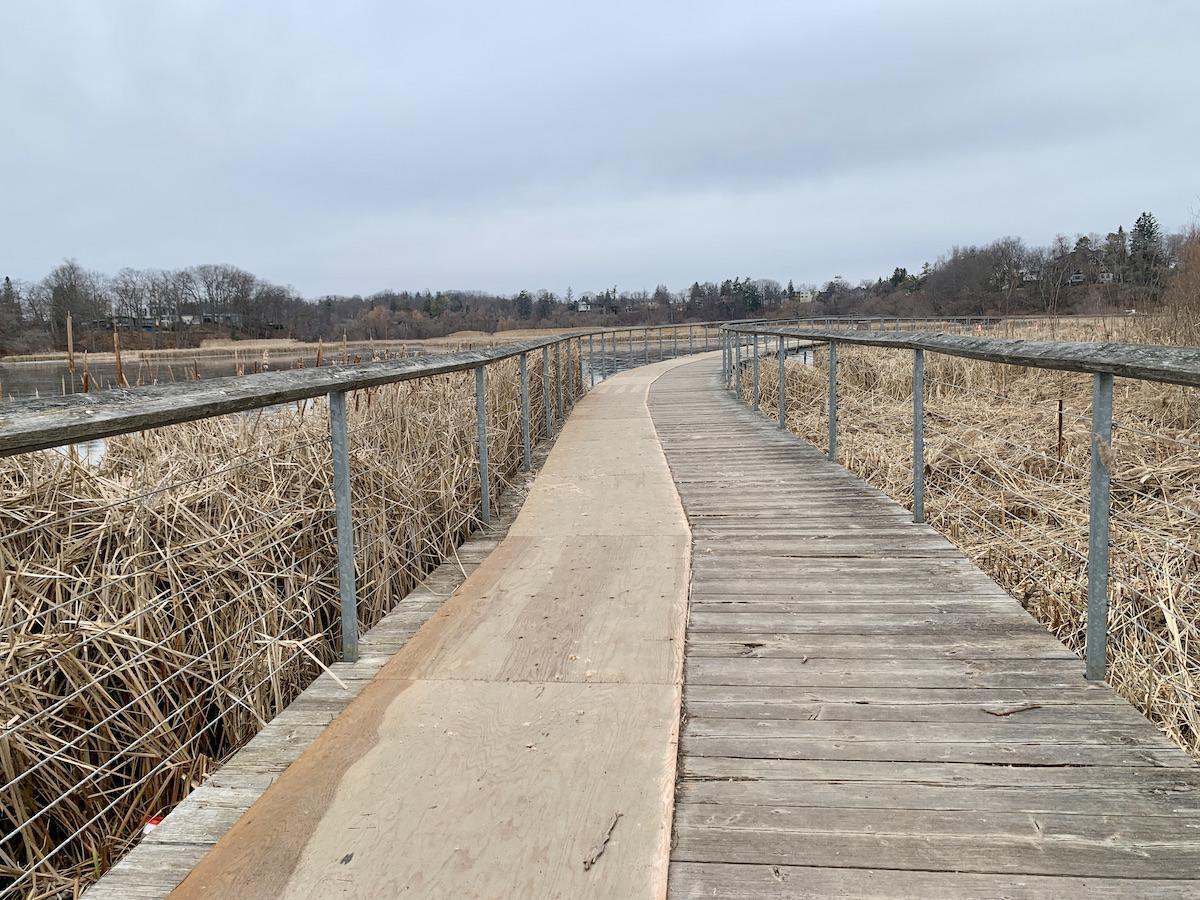
An artist's rendering of a a proposed boardwalk and pier at the southern marsh end of Rouge National Urban Park/Parks Canada
Rouge National Urban Park will accept public feedback on its Rouge Beach improvements Project until May 1 because of Covid-19.
The plan is to revitalize the Rouge Beach Day Use Area, one of the sprawling park’s most visited areas, create a trail connecting Rouge Beach to the Mast Trail, revitalize the existing Mast Trailhead, and add new boardwalk components. It will save, refurbish, restore and flood-proof park infrastructure and landscapes currently at risk from flooding and erosion while ensuring people can still access the beach and marsh.
“The pandemic has reminded us that we need to maximize our green, natural spaces, connect them to our neighbourhoods and to each other not only for the sake of the environment but for our own physical and mental well-being too,” says Waterfront Regeneration Trust Executive Director Marlaine Koehler in a comment posted on the “community support” area of the project’s website.
Rouge wrapped up its Beach and Boardwalk Technical Feasibility Report in December 2019, began the public engagement stage last March, and then decided to extend it six months.
Mindful of physical distancing, the park has tried to inform the public about the project, receive feedback, and address concerns. It has hosted walks, virtual meetings and community presentations, socially-distanced one-on-one meetings, phone calls, written responses, and web and social media messaging.
Parks Canada has received feedback from Indigenous partners, locals, community members, community groups and organizations. Most people are keen to see the area protected and to have better accessibility, but many have flagged concerns that include:
• Disturbance to the wildlife in the marsh
• The sensitive environment of the marsh
• Potential for increased garbage, noise and unwanted social issues
• Safety of visitors and locals
• Concerns about flooding and damage to infrastructure
• Access to the beach during construction
• Access to the water
• Increased vehicle and human traffic
• Questions on whether an environmental assessment will be done

A December 2020 view of the boardwalk through the marsh at Rouge National Urban Park/Parks Canada
Rouge — Canada’s only national urban park — is in the Greater Toronto Area and within reach of 20 percent of the country’s population. It protects Class-1 farmland, one of the region’s largest marshes, a beach at Lake Ontario and some of Canada’s oldest known Indigenous sites.
The park was officially created May 15, 2015, when the Rouge National Urban Park Act came into force. Since then, multiple parcels of land have been transferred to Rouge and it submitted its first management plan in 2019. Its first Parks Canada-built facilities and family-friendly trail have opened and an education and welcome centre is in the works.
Rouge is 95 percent complete and will eventually span 79.1 square kilometres (30 square miles) of Toronto, Markham, Pickering and the Township of Uxbridge and be 23 times larger than Central Park in New York.
Parks Canada has committed $7.5 million ($5.9 million USD) to the Rouge Beach Improvements Project.
Glenn De Baeremaeker — member of Friends of Rouge National Urban Park and a former deputy mayor of Toronto — said in a statement posted that the new boardwalk will “allow people access to the Rouge's beauty, but it will not allow them to go wandering all over the place and it will keep them away from the most sensitive parts of the marsh. Access for people and protection for nature at the same time. Amazing.”

An artist's rendering of a washroom proposed for the Lake Ontario beach area of Rouge National Urban Park/Parks Canada
From March to December 2020, a Let’s Talk Rouge website allowed people to share ideas on the beach and boardwalk trail components and draw attention to issues like ecological preservation and restoration, safety and security.
In January, the site was replaced by the Rouge Beach Improvements Project area of the park’s website that will provide project updates and a key place for public feedback.
During the extended engagement period until May 1, Parks Canada will conduct community co-design workshops/meetings and walks. People will be able to comment and provide feedback on the project’s Detailed Impact Assessment, which will be posted on the Impact Assessment Registry of Canada site.
Public engagement revolves around two phases of the project.
Phase one tackles climate change, flooding and erosion mitigation, and updates failing or decaying infrastructure. It will renovate the beach washroom facility, replace the sanitary lift station and line, add a pedestrian plaza and boardwalk pier, decommission and restore the lower beach parking lot, redesign the upper parking lot to compensate for lost parking and improve traffic flow, and relocate the primary canoe/kayak launch zone closer to the upper parking lot. Work should start this fall and wrap up by summer 2022.
Phase two will tackle more detailed ecological restoration, formalize existing trail connections, and add boardwalk and bridge connections. There will be restoration work, tree planting, invasive species removal, habitat creation for species-at-risk, litter and contamination removal and clean-up, wildlife crossings and passages, and safety features of the boardwalk trail and bridges. Work should start in summer 2022 and finish in fall 2023.
People can email questions, comments and meeting requests to [email protected].

 Support Essential Coverage of Essential Places
Support Essential Coverage of Essential Places



